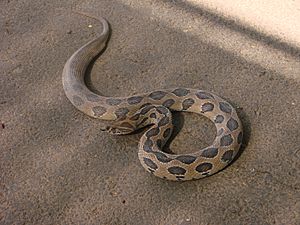Viperinae facts for kids
Quick facts for kids Viperinae |
|
|---|---|
 |
|
| Chain viper, Daboia elegans, a viperine | |
| Scientific classification |
|
| Kingdom: | Animalia |
| Phylum: | Chordata |
| Class: | Reptilia |
| Order: | Squamata |
| Suborder: | Serpentes |
| Family: | Viperidae |
| Subfamily: | Viperinae Oppel, 1811 |
| Synonyms | |
The Viperinae, also called Viperines, are a group of venomous snakes. They are a subfamily of vipers. You can find them in Europe, Asia, and Africa.
There are 12 different groups (called genera) and 66 types (called species) of Viperines. Most of these snakes live in warm, tropical or subtropical places. However, one type, the Vipera berus, lives even in very cold areas near the Arctic Circle.
About Viperines
Viperines come in many sizes. The smallest is the Namaqua Dwarf Adder, which grows to about 28 centimeters (11 inches) long. The largest is the Gaboon Viper, which can be over 2 meters (6.5 feet) long!
Most Viperines live on the ground. These are called terrestrial snakes. But some, like the Atheris vipers, live entirely in trees. These are known as arboreal snakes.
Where Viperines Live
Viperines live across three continents: Europe, Asia, and Africa. However, you will not find any Viperines on the island of Madagascar.
How Viperines Reproduce
Most Viperines give birth to live young. This is called being viviparous or ovoviviparous. It means the babies grow inside the mother and are born alive. A few types, like the Persian Horned viper, lay eggs instead.
Types of Viperines
Here are some of the different groups (genera) of Viperines:
- Uzungwe viper (Adenorhinos)
- Bush viper (Atheris)
- Puff adder (Bitis)
- Horned viper (Cerastes)
- Russell's viper (Daboia)
- Saw-scaled viper (Echis)
- McMahon's viper (Eristicophis)
- Large Palearctic viper (Macrovipera)
- Kenya mountain viper (Montatheris)
- Lowland viper (Proatheris)
- False horned viper (Pseudocerastes)
- Palearctic viper (Vipera)
See also
 In Spanish: Víbora para niños
In Spanish: Víbora para niños

